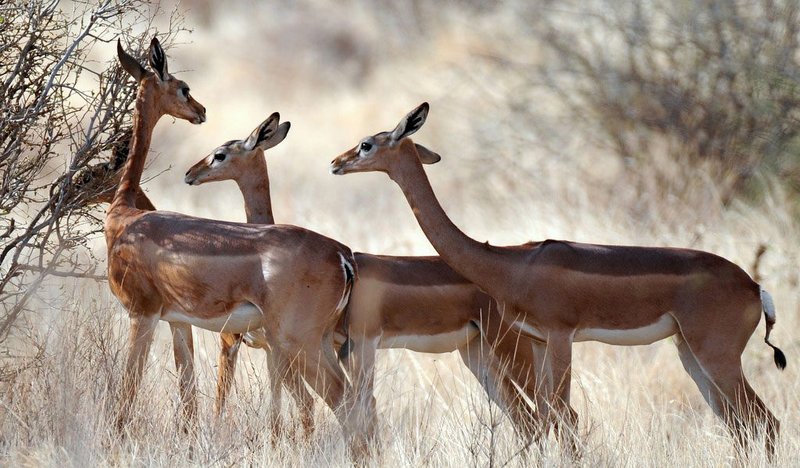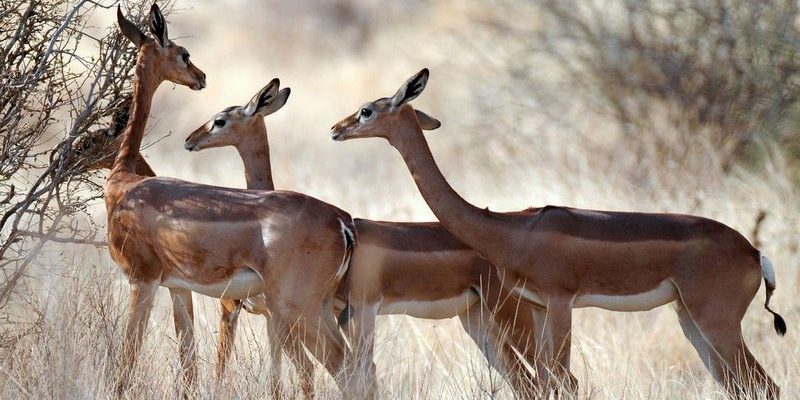
Gerenuks are more than just good looks. They have some fascinating adaptations that set them apart from other antelope species. So, let’s dive into the world of the gerenuk, exploring 10 amazing facts that highlight why this creature should be on your radar.
1. Unique Adaptations for Browsing
Gerenuks are built differently than other antelopes. Their long necks, which can be up to 30 inches long, allow them to reach higher foliage that most grazers can’t access. Here’s the thing: while other antelope munch on grass, gerenuks prefer leaves and shoots from bushes and trees. This browsing behavior lets them thrive in arid environments where food is scarce, making them a perfect example of nature’s ingenuity.
Their necks aren’t just for show. You might be wondering how they balance such a long structure. Gerenuks have a strong musculature and flexible spine, which helps them maintain stability even when they stand on their hind legs. When they stretch up, they can look like a mini giraffe, making their feeding routine both fascinating and efficient.
2. Social Structure and Behavior
Gerenuks are social creatures but have a somewhat unique way of interacting compared to other antelopes. They form small groups, usually made up of females and their young. Males tend to be loners, asserting their dominance through displays of strength rather than forming large herds.
Interestingly, these animals communicate using body language. For instance, a gerenuk will raise its head high to look out for danger or crouch low when it feels threatened. It’s a bit like a dance, with each movement sending signals to others. When you watch them, it’s easy to see how skilled they are at navigating their environment and maintaining social bonds.
3. Habitat and Range
You’ll find gerenuks primarily in the dry, open savannas and scrublands of East Africa, mainly in countries like Kenya and Tanzania. They thrive in semi-arid regions, where few other animals can easily find food. Their ability to live in such harsh conditions is a testament to their resilience.
Their habitat plays a crucial role in their survival. Gerenuks tend to stay in areas with plenty of acacia trees, which are their favorite snack. When you think about it, it’s amazing how well they adapt to their surroundings, finding food where others might struggle.
4. Diet: More Than Just Grass
Speaking of food, the gerenuk’s diet is quite remarkable. Unlike many of their grazing relatives, gerenuks prefer to nibble on leaves, flowers, and fruits from bushes and trees. They can eat a variety of plants, but their top choices often include acacia leaves and pods.
This browsing lifestyle has its perks. Not only does it allow them to reach food that other herbivores can’t, but it also means they can find nourishment even when grass is sparse. They are a bit like nature’s foragers, proving that creativity in diet can lead to thriving in challenging environments.
5. Conservation Status
Unfortunately, like many species around the world, gerenuks face threats to their survival. Habitat loss due to farming and urban development poses a significant risk. Additionally, hunting for bushmeat and competition with livestock can impact their populations.
Conservation efforts are in place to help protect this species. Organizations are working to preserve their natural habitats and raise awareness about their plight. Supporting wildlife conservation is vital in ensuring that future generations can admire the beauty of the gerenuk.
6. Gerenuks and Predators
In the wild, gerenuks have to stay alert. Their main predators include lions, leopards, and hyenas. To protect themselves, gerenuks rely heavily on their keen senses. They have excellent eyesight and can quickly spot threats from afar.
Interestingly, they also have a unique way of escaping danger. If a predator gets too close, they often freeze, blending into their surroundings to avoid detection. It’s like playing hide and seek, but their instincts are finely tuned to keep them safe from harm.
7. Breeding and Reproduction
When it comes to breeding, gerenuks have a fascinating process. Males will often compete for the attention of females through displays of strength, such as stotting—jumping high into the air to show off. It’s a bit like a gymnastics routine, with males showcasing their agility to woo potential mates.
After mating, a female gerenuk typically gives birth to a single calf. The calf stays close to its mother for protection and nourishment. Gerenuks are attentive parents, guiding their young as they learn to navigate their environment. Watching a mother and calf interact is a heartwarming experience.
8. Lifespan and Health
In the wild, gerenuks can live up to 10 years. In protected environments, they can live even longer. Like all animals, they face health challenges, including diseases and injury, which can impact their lifespan. Their ability to adapt to their surroundings certainly helps them maintain good health, but vulnerability remains a constant.
Providing safe habitats and protecting them from poachers can significantly contribute to their longevity. That’s why conservation efforts focus not just on the animals themselves but also on creating environments where they can thrive.
9. Gerenuks and Humans
Humans have a complicated relationship with gerenuks. While they are not heavily hunted compared to other species, habitat encroachment poses a significant risk. Many local communities rely on the same land for agriculture, often leading to conflicts.
However, awareness and education about the importance of preserving wildlife can help bridge this gap. By promoting ecotourism and sustainable practices, it’s possible to create a win-win scenario for both people and wildlife.
10. Gerenuks in Captivity
In captivity, gerenuks can thrive if given the right conditions. Zoos and wildlife parks around the world work hard to replicate their natural environments to ensure their well-being. They often thrive in enclosures designed to mimic their natural habitats, providing ample space and food sources.
Visitors can sometimes see these unique animals up close, allowing for education and appreciation of their beauty. Seeing a gerenuk in person can change your perspective on wildlife and conservation, making it clear how vital it is to protect such incredible creatures.
As you can see, the gerenuk is not just another pretty face in the animal kingdom. Its unique adaptations, fascinating behavior, and the challenges it faces make it a remarkable species worth learning about. By understanding and respecting these creatures, we can contribute to their survival and the preservation of their habitats. Every little bit helps, and together, we can make a difference!

